Written by Joe Jackson photos courtesy of Derek Fergus
It’s July 7th, 2003, and the night sky around Cape Canaveral Air Force Base in Florida is suddenly whelmed in fire. The National Air and Space Administration’s Delta II Heavy rocket surges upward, its $400 million payload destined for a mission far, far away. A little over six months later, that payload—a dastardly intelligent rover named Opportunity—will make contact with its destination and proceed to give mankind some of its first true insights into a world beyond our own; the lonely, windswept rock known as Mars.
You’re likely scratching your head and wondering just how the 2003 Mars Expedition Rovers (of which there were two) can in any way be related to fly tying. I’m still wondering the same thing myself. But let’s forget about the bobbin and the vise for a moment and consider just what a Mars rover must do in order to be successful. First, it must reach a speed in excess of 25,000 miles an hour to exit Earth’s atmosphere. Check. Second, it must reach Mars via a dizzyingly complex series of calculations, not to mention impeccable timing. Check. Finally, it must be able to withstand not only the absurd heat of entering Mars’s atmosphere (something like 2,400 degrees Fahrenheit), but, upon landing, it has to endure the Red Planet’s chilly average surface temperature of -81 degrees Fahrenheit. Without this ability to cope with such extremes, the project would’ve been dead in the water. Opportunity was only slated to trundle around Mars for 90 days, but it ended up surviving nearly 15 years thanks, in large part, to its insulation. Derek Fergus uses that same insulation to tie dry flies.
Aerogel, or “solid smoke” as the cryptic substance is often called, is a silicon-based material composed of 99.8% air. It is, therefore, one of the best (if not the best) insulators and water repellents known to mankind. Fergus doesn’t use solid smoke as body or wing material; instead, he secures a small knub of the stuff to his bobbin so that as his thread passes over it, it picks up some of the Aerogel’s residue and, along with it, a superb ability to repel water.
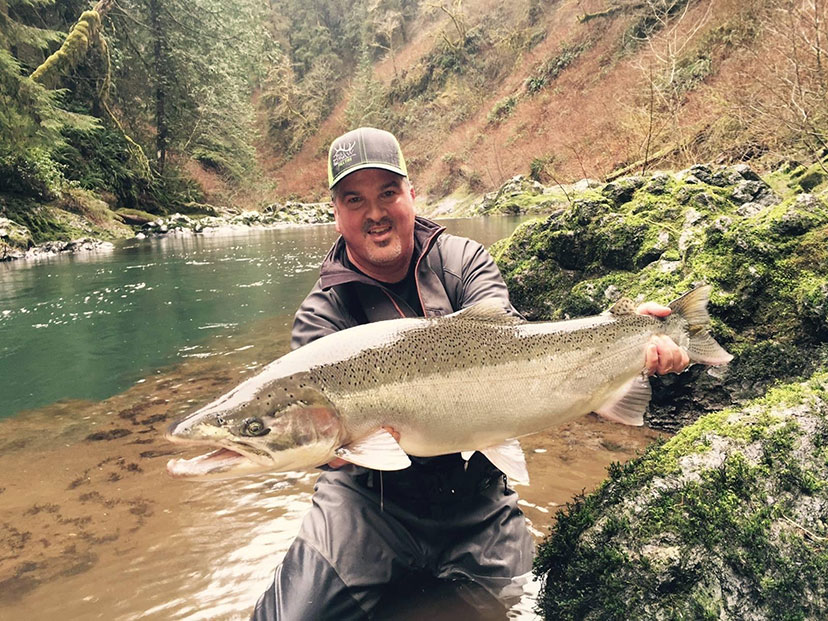 Fergus and a titan steelhead from a well-hidden stream.
Fergus and a titan steelhead from a well-hidden stream.
I should rephrase here and say that Fergus doesn’t use Aerogel on all of his dry flies—I don’t know how anyone could afford to given that Aerogel is currently more expensive, by weight, than gold. He does, however, use it almost exclusively for a fly he calls the “Freestone;” a pattern meant to imitate Deschutes River salmonflies and be, according to Fergus, “totally unsinkable.” Between the Aerogel-ed thread, an articulated and fine-wire hook, and several layers of both foam and poly yarn, the Freestone is every bit as effective for its purposes as the Mars rovers were for theirs.
Derek Fergus began and remains an innovator. Take his Peekabou Leech for example, a pattern he developed at the nascent age of ten and which has remained a staple in his fly box ever since. Fergus started tying well before he started flyfishing, and the former began on a high desert lake in Oregon where he grew up.
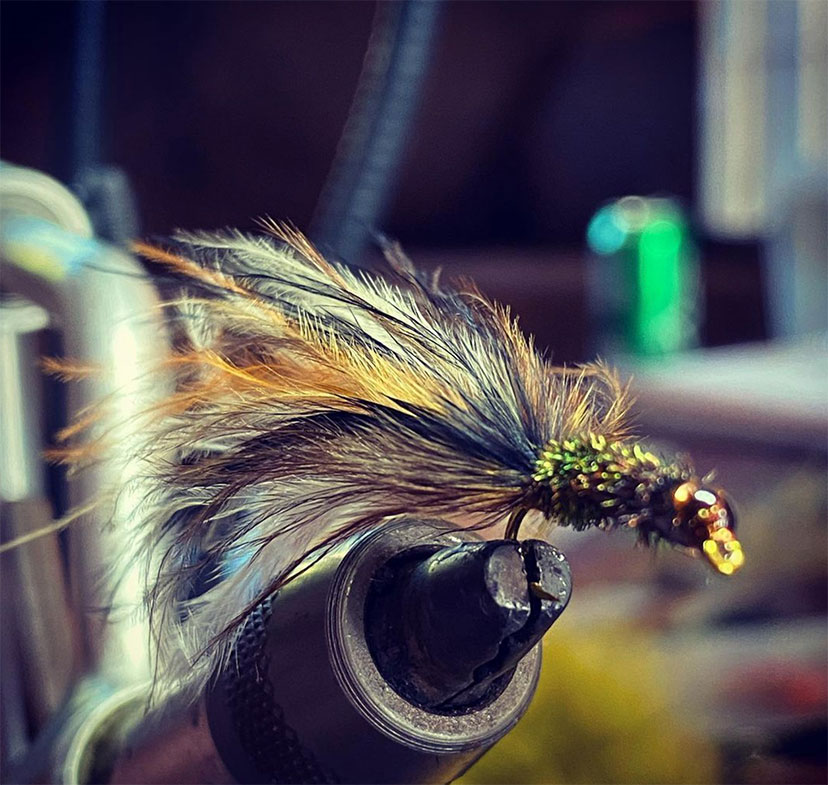
Where it all began; the one and only Peekabou Leech.
“You want to tie something that looks like this,” an anonymous fisherman said, holding a wriggling leech in his palm for young Derek to see. Around them, the sun was blistering and chitinous insects were trilling from the sagebrush.
Several days and a $7.95 vise later, Fergus did just that: He tied something that looked almost indistinguishably like the side-winding leech, and he did it with just two materials. Since that time, the Peekabou Leech hasn’t changed much except by racking up a resume of impressive trout and even going so far as to win Fergus a tournament just a few years ago. What sounds like a boyhood memory—as halcyon as any—would come to be Derek Fergus’s driving principle. How can I make this look natural? How do I make this work? Incidentally, years later when Fergus had become somewhat of a titan in the commercial side of flyfishing, a number of fly companies refused his Peekabou Leech on the grounds that it was “too simple.” Apparently, they haven’t heard of Occam’s razor.
As the years flicked by, Derek’s childhood became populated by more flies and more fish. He had since advanced to a Regal vise, for which he traded 10 dozen Elk-Hair Caddises. Impressively and amusingly, this bartering system would continue into later life, when Fergus flies could be exchanged for anything from beers to medical treatment. By the age of 20, at the same time that he fell off the deep end of flyfishing, Fergus was working at Nordstrom as a shoe salesman. This only lasted a few years before the shackles of a 9-to-5er made Fergus feel like a bird dog trapped in an apartment complex, so he cashed out his 401(k) and took to the streams while living out of his truck.
Fergus and I joke about living in trucks and being, as John Gierach coined with his 1986 cult-classic book, “trout bums.” These days, angling hipsters will give anything to convert their vehicles into mobile dwellings, salivating over the advents of power converters and inflatable sleeping pads and rod racks. (I’ll freely admit that I’m one of these aspiring souls). All it takes is a glance at a Yakima or Patagonia catalog to see that, for quite a literal fortune, you can do just that, and it’s almost become a status symbol to achieve this level of angling independence. In Fergus’s day however, he assures me with plenty of good humor, the fact that he lived in his truck and basically just fished for three years was to the utter and ultimate chagrin of his parents. By night, their son was crumpled up beneath a camper shell, and by day he was chasing steelhead, trout, and salmon with dogged enthusiasm. Despite what others thought he ought to be doing, though, the whole arrangement ended up working for Fergus; before too long he was guiding in Alaska alongside such characters as George Cook and dipping his toes into the commercial fly game as a sales rep.
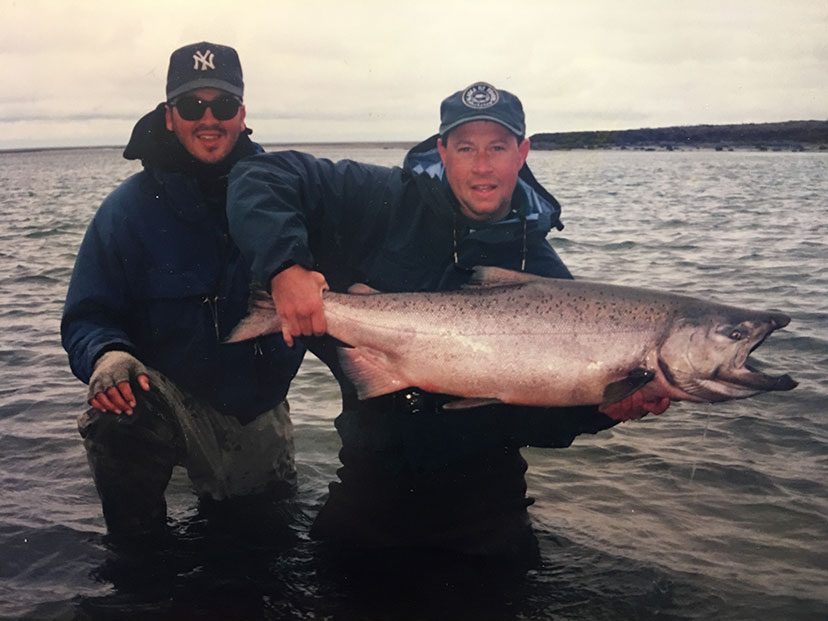
There’s a whole lot of legendary in this shot: George Cook and Derek Fergus hoisting a mammoth Alaskan king.
These formative years of fishing and interacting with scores of anglers on a daily basis proved one thing to Derek Fergus: Most people were (and are) just too caught up in collective dogma. They accepted what was and did little venturing into true innovation. Sure, you’d have a leap forward every now and then, but it was more of a slow, glacial crawl. It’s a difficult thing, after all, to inch your way along the cutting edge and abandon previous ideals for the sake of something truly novel. It’s difficult to develop a fly that’s unlike anything that’s ever been done, in the same way that it’s difficult to send the first human-created robot to Mars.
But Fergus is that innovator. He’s got no problem with feeling around in the dark for something that will work, even if that something takes dozens of iterations to perfect. Some of his recent developments in the outdoor world are good examples of this. His Rugged Maps project prints and sells detailed hunting and fishing maps on waterproof fabric; a modernism that may seem like a no-brainer but one that failed to exist until Fergus gave it a try. His revolutionary series of bow-hunting decoys, currently under development, makes use of a one-way mesh that attaches directly to the hunter’s bow and gives them the appearance of their quarry from the frontal perspective. Back in 2001, the Fergus invention was slightly more modest than indestructible maps or never-before-seen decoy lines, though it was, in the words of Alaska Flyfishing Goods owner Brad Elfers, “a quantum leap in fly tying.” Enter the Mother Of All Leeches, affectionately dubbed the MOAL.
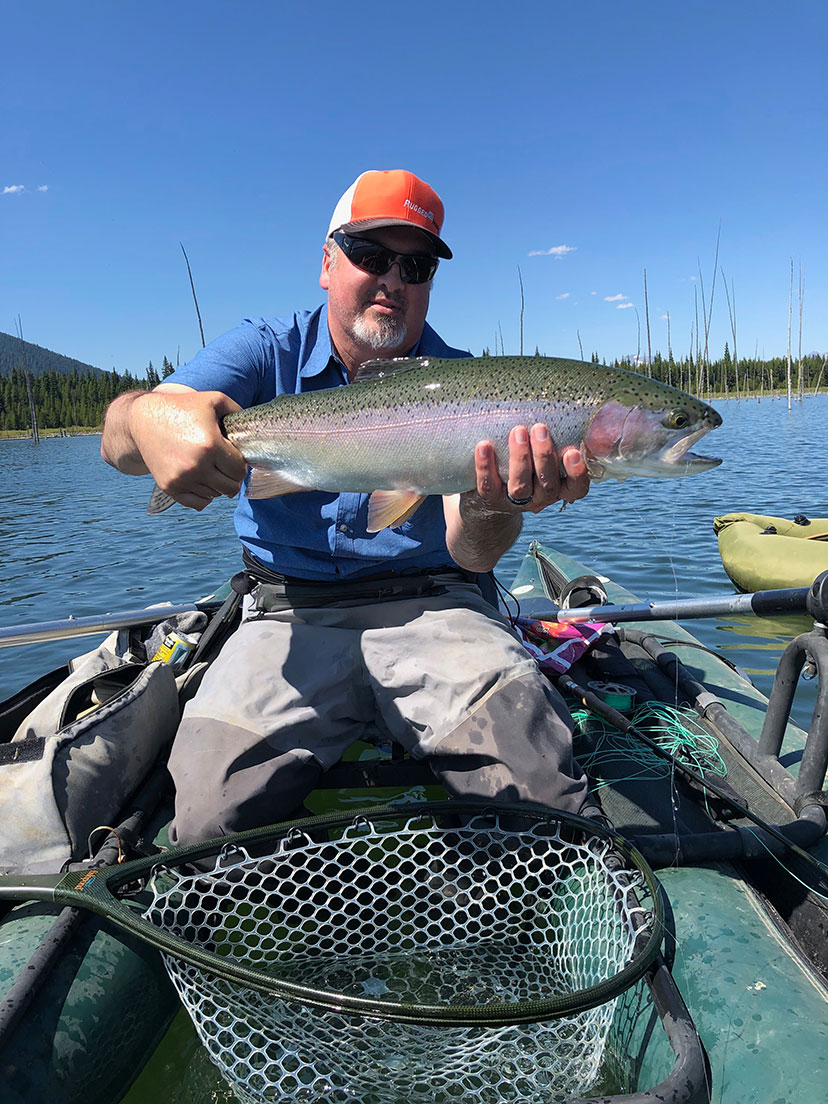
Fergus showing off some of his stillwater prowess.
Where the Peekabou Leech is a study in extreme simplicity, the MOAL is at the opposite end of the spectrum. This is a fly that takes two vices to tie correctly, and it was the very first pattern to feature body material wrapped around the shank-to-hook backing connection. By 2001, articulation was nothing new. The Intruder gang of the early ‘90s began a systematic replacement of long-shanked steelhead and salmon flies. Not only were these archaic hooks far more damaging to fish, but the extended shanks made the hook points easier to throw. The beauty of articulation, of course, is that the large-profiled flies that anadromous chasers had come to crave could be achieved while still using small, compact hooks that held fish better and did less damage.
There are two ways to go about articulation. One is to use a stiff connection between the hook and the shank; often wire specifically developed for such flies. The other method is to use Dacron backing material or similar, which creates a flexible “spine” and allows the hook to wiggle mostly freely behind the fly material. In both cases, before the MOAL at least, material was only wrapped around the shank section. The trailing hook and backing or wire connection was blank and unoccupied.
Fergus decided that an opportunity had been missed. Why not tie stuff around the Dacron connector? It would make the fly far more flexible and exponentially swimmy. The theory proved valid, but the actual doing was difficult. After eight hours of experimentation, though, Fergus had it. He used two vises to achieve just the right tension on his Dacron (hook in one vice, shank in another), he employed Super Glue in copious amounts, and he proceeded to wrap a rabbit strip proverbially “where no man had gone before” in a technique that’s since become known as the “strung out” method. The result was a fly that swam unlike anything else on the market, and which has remained a tried-and-true for over two decades. Interestingly, the “strung-out” technique that the MOAL introduced is actually patented by Fergus himself.
Over the ensuing years, and as those years turned into a decade plus, Fergus’s “strung out” fly technique gained some traction with numerous variations like the Strung Out Tonya Harding (a dry fly), the Rockstar (a stellar Chinook fly), and the Strung Out Thunder Creek, among others. Meanwhile, Fergus himself ran around the western United States representing various flyfishing brands, while also staying fairly active (and successful) in fly casting tournaments and continued guiding stints. The mid-2010s brought new winds to the commercial flyfishing sector, however, and some friction with a few of his brands led Fergus to go independent just months later.
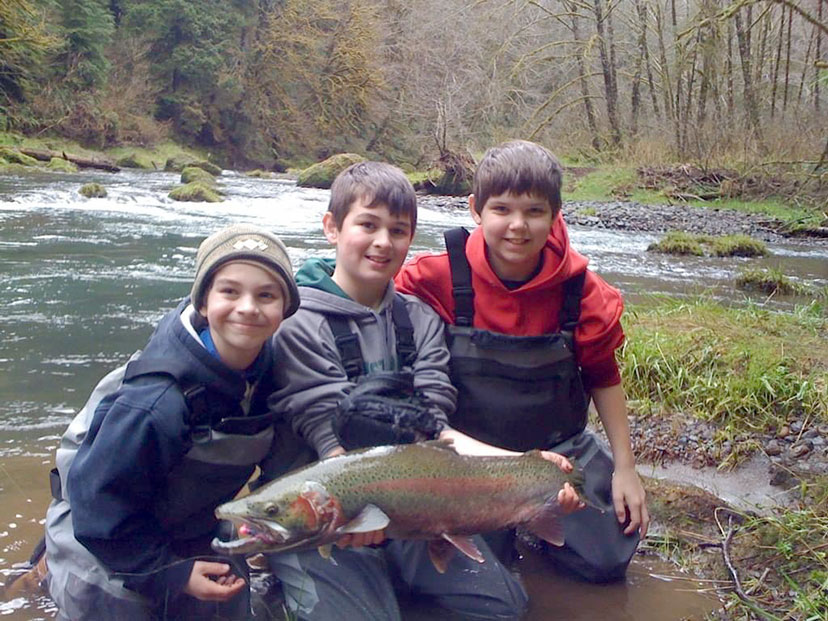
It’s clear that chrome runs through the veins of the Fergus family.
Luckily for him, those ten-plus years of brand repping had presented numerous opportunities to see outdoor products, how they were made, and how he could do it better. His mind quite literally bursting with ideas—including those that would culminate into his Rugged Maps series and the aforementioned mesh decoy—Fergus dove headfirst into a variety of pursuits. He opened a fly factory in Vietnam, experimented with harnesses for hunting and fishing, was among the first to suggest sonic welding in wader material (a technique that’s now an Orvis and Simms standby), implored esteemed rod makers like Gary Loomis to try out certain tapers, and founded a venture known as 20sub3 to capitalize on his wealth of ideas. Dismally, the business went bust a few years later, though Derek turned immediately to his Rugged Maps project which has been alive and well since then.
These days, Fergus is still doing some absurdly clever things behind the vise. His Peekabou Leech is still in commission and comes in several editions. Some versions feature as many as eight different colors of marabou in the tail, which Fergus uses to simulate both the biological splendor of leeches and an illusion of flash. He’s also taken to adding monofilament “lips” at the eye of the hook, almost like a miniaturized crankbait lip. As our phone call stretches for one hour, then two, then three, Fergus relates stories of stillwater fishing (along with a good many tips that I intend to use as soon as possible), and we migrate back to the inevitable topic of steelhead.
While he still fishes the MOAL, Fergus has adapted another revolutionary tool in the anadromous angler’s fly box: the bead. Love ‘em or hate ‘em, it’s no question that the advent of beads represented a significant jump forward for all of angler-kind. The most interesting thing about this to Fergus, though, is that in the decades since they emerged, they’ve been fished the exact same way. In an effort to combat this, Fergus has developed what he calls the Jiggabead, a specially-designed jig hook that allows a bead to be suspended underneath. He’s tinkered with it even further to produce the Freeballer, which is essentially a bead dangling freely under a #6 hook (or smaller) using earring stoppers. Once you see it, the Freeballer is similar to the MOAL; you might stare for a moment, scratch your head, and wonder why no one’s tried it before.
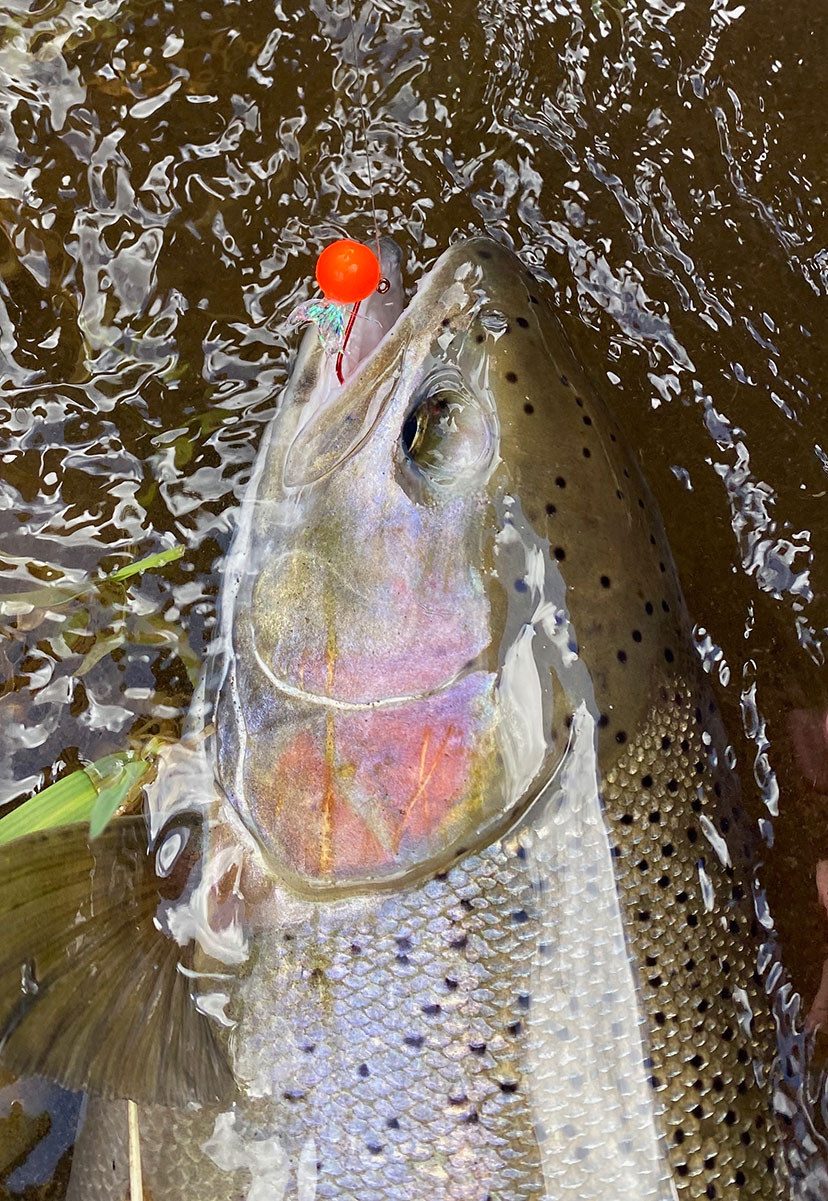
The innovative Jiggabead is a new spin on an already revolutionary bit of angling gear. Here a steelhead demonstrates its effectiveness.
It’s been nearly two decades since the first human-created object landed on Mars. Since then, our knowledge of the Red Planet has grown exponentially. The late 2010s and these early 2020s have been abuzz with efforts for further Martian exploration. Intellectual titan Elon Musk has claimed that we will put a human on Mars by 2026, and his company, SpaceX, is making decent progress toward that vision. A new Mars rover, this one dubbed Perseverance, was launched on July 30th, 2020, with the intention of collecting actual rock samples from its destination and storing them for return to Earth. It landed in February 2021 and has been tottering around ever since, succeeding in its vital purpose and just waiting for someone to analyze its sample tubes.
The parallels between space exploration and fly tying are difficult to draw (unless you, too, use space-grade materials in your tying). Really the only connection we can make is symbolic; both pursuits are built upon the shoulders of their respective giants, and both artforms rely on the steady progression of knowledge punctuated by occasional quantum leaps. We can get to Mars (maybe) because we once got to the Moon, just like we can tie a MOAL because we once tied an Intruder because we once tied a bucktail streamer.
When viewed as a larger timeline, and in retrospect, of course, the advances are easy to spot. It’s an evolutionary process. In the moment, though, it’s all too easy to assume that our sport has become stagnant; that all of the patterns have been tied and tried—at least the truly innovative ones—and that all we can alter now is color, size, and perhaps how we fish things. Such widespread belief has led to conventions about what we can and can’t do, maybe not strictly but definitely subconsciously, and it is this dogma that Derek Fergus has fought since the beginning in his efforts to make things work. It goes all the way from his Peekabou Leech, the Freestone, and the MOAL (and various other patterns not mentioned here), to his myriad of tying techniques that range from dipping beads in soft, clear rubber to using sections of old sinking lines as nymph legs. It seems that everything he does is novel or is at least inspired by a fresh mind that’s spent decades observing and loving the things that swim.
Perhaps in a few years we’ll send more rovers to Mars. Maybe NASA or SpaceX will concoct some fancy new material to stuff in their rockets that Derek Fergus will later use for his steelhead nymphs. Shoot, maybe in a few years we’ll send a person up there, and maybe instead of the golf clubs we once brought to the Moon, we’ll bring an 8-weight and a box of MOALs to Mars. Here’s to hoping.
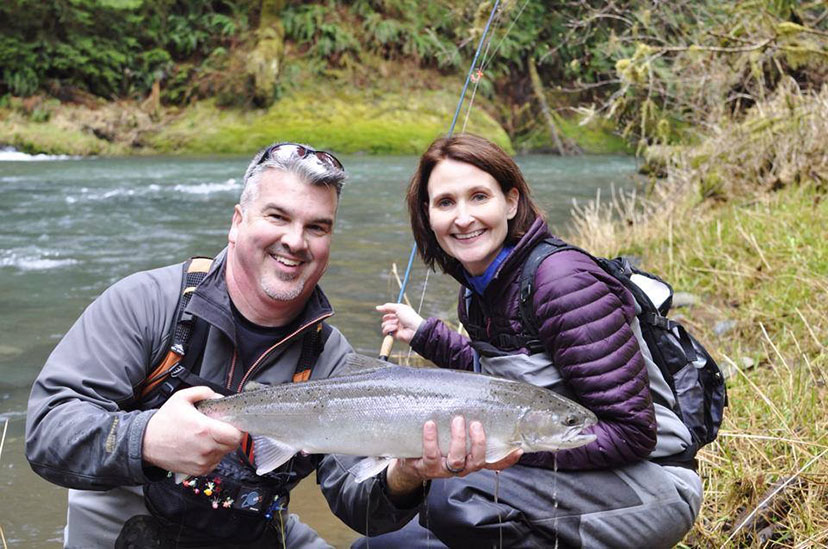 Derek and his wife, Lisa, with a dime-bright steelhead.
Derek and his wife, Lisa, with a dime-bright steelhead.
Joe Jackson is a fly nerd who wishes to thank each and every subject of “Behind the Vice” for indulging his curiosity. Joe has written for Fish Alaska, The Flyfish Journal, The Drake, American Flyfishing, Alaska Magazine, and Fur-Fish-Game.


